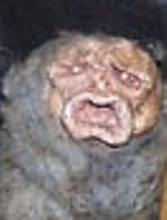PIG no. 05049 was only one of millions of pigs slaughtered for human consumption, but this pig stands out from the rest because he had a different kind of afterlife.
Well, that's not entirely true - his afterlife was really the same as all the other pigs - but this one got the added bonus of being thoroughly documented by artist Christien Meinderstsma. The following text comes off the artist's website, describing the project:
Christien Meindertsma has spent three years researching all the products made from a single pig. Amongst some of the more unexpected results were: Ammunition, medicine, photo paper, heart valves, brakes, chewing gum, porcelain, cosmetics, cigarettes, conditioner and even bio diesel.
Meindertsma makes the subject more approachable by reducing everything to the scale of one animal. After it's death, Pig number 05049 was shipped in parts throughout the world. Some products remain close to their original form and function while others diverge dramatically. In an almost surgical way a pig is dissected in the pages of the book - resulting in a startling photo book where all the products are shown at their true scale (1:1).
(The following graph is an overview of all the product numbers included in the book, arranged by physical origin from the pig.)
PIG 05049 is a remarkable book, consisting of precise measurements, with all sorts of graphs and tables, of all the pig parts that are used by us humans. The artist then follows every direction where the animal parts go, with a short description and photographs of each item. The amount of things that have bits of pig are astounding: the book showcases 185 products that have parts of this single, slaughtered pig.
For anyone who's interested in veganism, this should come as no surprise. It is quite easy to get lists and tables of all the different sorts of products and chemicals that include animal derivatives, but to see it presented in such a visual way is amazing stuff. It is a mesmerizing book and truly a work of art, making our understanding of the large role animals play in consumer society crystal clear.
This clearly dispels the myth that animal bodies are not put to the same use as they were in olden times. But there is a clear-cut difference between the farming societies of old - putting every piece of skin, meat and bone to good use - and the end-products of today's market. In the foreword, after discussing the old ways of farming using Sicily as an example, Lucas Verweij writes about the difference of the new and old markets:
The overseeable scale of a Sicilian village has been replaced by an unfathomable world scale. The food industry has rapidly become more refined than the centuries-old Sicilian traditions. This frugality goes hand in hand with far-reaching globalisation.
The scale of one pig, which is the unit used in this book, has long been forgotten as the scale at which to trade. This is because, on the scale of one pig, it makes no sense to seperate out a few milligrams of black pigment, gelatin or collagen. It only makes sense if you are dealing with tens or hundreds of pigs every day.
... or, rather, hundreds of thousands?
So with mass murder comes mass production. How else could we get 185 items out of a single pig?
(The following image shows a "FINE BONE CHINA FIGURINE" (from BONEs -> BONE ASH) and includes this description: Bone ash is aded to fine bone china to achieve a high degree of strength and translucency. Amongst other things, it is used for making hand painted figurines.)
Meindertsma has used animals in her art before, also focusing on the utility of a single animal, in a piece called One Sheep Cardigan. There she used the whole amount of wool taken from a single sheep and made a single cardigan out of it. The results, needless to say, were of different shapes and sizes, according to the individual wool donors.
More information on Meindertsma and her work can be found on her official website.
Also, a fine interview about the PIG 05049 project can be read here.
Finally, it should be noted that the book was supported by an organization called IMAGRO - Strategy and creativity for the agricultural and food industries - and includes the following message from them:
We hope this book will serve as a contribution to our original mission: reduce the gap between producer and consumer. We do this not out of sentimental reasons, but on the basis of our core values. This led us to support Christien Meindertsma in regard to her art project.
(The following image shows a "DEEP FRIED NOSE" (from MISCELLANEOUS -> HEAD) and includes this description: Deep fried pig nose is given to dogs as a snack.)

No comments:
Post a Comment